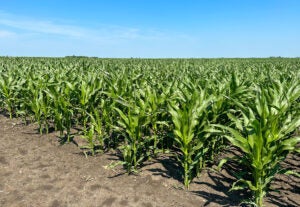During harvest, it’s easy to recognize a corn field that has dried out. And, in areas where weeds are present, another thing often becomes clear to the grower: Corn plants are stunting, with their leaves curling due to lack of water and necessary nutrients.
The diminished numbers on the yield monitor then drive home the seriousness of the issue.
Once weeds are established in a corn crop, they initiate a long and aggressive campaign for the same resources on which a corn crop depends: water, nutrients, and sunlight. It’s vital to address weed pressure in corn fields early, as the consequences of a delayed response are compounded when weeds gain a few inches in height.
Yet, even a one- or two-inch weed, especially one as notorious as Palmer amaranth, can become terribly competitive.
“Studies have shown that if you let weeds compete with the corn, you get 17 percent more foliar growth and 15 percent less root growth,” said Mark Kitt, Technical Product Lead for Corn Herbicides with Syngenta. “And you need to make sure that those corn plants have a strong root system, because roots absorb more water and nutrients, and that’s what drives yield.”
He also noted data shows that weeds can take in about $25 an acre in key nutrients such as nitrogen, phosphorus, and potash. And once absorbed by a weed species, a nutrient is not going to be available to the crop that growing season, even if the weed is killed with a post-emergent spray.
Failure to act early can impact yield potential by as much as one percentage point per corn-growth stage and backs a grower into a corner where yield loss is ultimately irreversible. Maximizing the corn plant’s yield potential rests at the doorstep of its neighboring weed.
Water is one of the major driving factors in corn yield, so weeds that take up moisture from the crop during all crop development stages can impact yield potential. Syngenta has a guideline that says in three days, a three-inch weed can remove one inch of moisture out of the soil profile — call it the 3-3-1 rule.
“Anything growers can do to prevent weeds from competing with the crop for water, nutrients, and light is going to result in a more vigorous crop and a higher yield potential at the end of the season.” — Pete Eure, Syngenta R&D Regional Head for the Eastern United States
Weeds such as Palmer amaranth and waterhemp, which have been especially problematic for growers over the past 15 years, excel under hot, dry conditions because of their ability to steal soil moisture so efficiently. Palmer can grow from a few inches to five to six inches in a matter of days.
“This results in stress on the crop, and that stress can result in a yield reduction,” said Pete Eure, Syngenta R&D Regional Head for the Eastern United States. “There’s not only scientific publications that show this, but there are many growers that have experienced the impact of drought on yield potential over the last few years with the dry weather across the U.S. Anything growers can do to prevent weeds from competing with the crop for water, nutrients, and light is going to result in a more vigorous crop and a higher yield potential at the end of the season.”
Stress responses in corn plants can be separated into two distinct categories:
- In areas where weeds are not controlled, the first visible sign of drought occurs when the soil begins to dry out and the corn leaves begin to roll up. The corn will lose some of its lush green appearance and take on a more silvery appearance.
- Then, if prolonged drought occurs, stunting of the corn crop starting in the V5 to V10 growth stages will be visible in areas where there is significant weed pressure. This is likely due to the soil drying out faster in areas where high-density or troublesome weeds are present.
Because of how impactful even small weeds can be, it’s important to use residuals like Storen™ corn herbicide to address weed pressure.
Using full labeled rates of herbicides like Storen provide long residual control, so that weed pressure is addressed before it affects water and nutrient availability. This approach is especially important up to canopy closure, which usually occurs around the V10 to V12 crop stage. For the best results, it’s recommended to apply Storen early on, targeting those one- to two-inch weeds.

Storen can be applied pre-plant or post-emerge in a weed management plan. Storen provides a flexible approach that allows growers to adapt to heavy wind or rain events that keep them out of field, as well as to any equipment breakdowns that may occur.
“Grower surveys indicate roughly 40 percent of the growers already lament difficulties battling waterhemp or pigweed species,” Kitt said, “so broader spectrum control and a longer-lasting residual such as Storen have distinct advantages in this space.”
Eure said rule No. 1 in any conflict is always know your enemy, and it is a red flag in a water management plan to let weeds thrive during the growing season, especially in places like Nebraska and Kansas, where drought has been a concern. Every drop of rainfall and irrigation counts and giving corn plants the opportunity to get the most out of every drop of water will benefit the grower.
And the issue of weeds isn’t just a one-year decision — allowing weeds to go to seed ensure that problems will be sown in fields for the next several growing seasons.
“It’s widely recognized that the presence of weeds in a corn field will not only reduce yield, but if left uncontrolled, can also produce seed that can remain viable in the soil for years to come,” Eure explained. “That makes weed control difficult not just this year, but next year as well, and even further into the future.”
This article was published on behalf of Syngenta. Visit this page to find a Syngenta Crop Protection Specialist near you.
Ryan Tipps is the founder and managing editor of AGDAILY. He has covered farming since 2011, and his writing has been honored by state- and national-level agricultural organizations.



